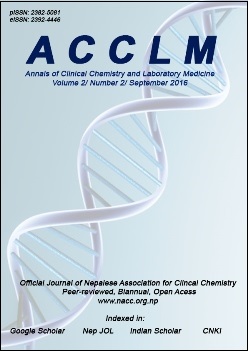Biochemical changes in Non-alcoholic fatty liver disease (NAFLD): A study in Nepalese Population
DOI:
https://doi.org/10.3126/acclm.v2i2.15597Keywords:
Nonalcoholic Fatty Liver Disease (NAFLD), Lipid profile, Liver function test (LFT), BiomarkerAbstract
Background: Non-alcoholic fatty liver disease (NAFLD) has emerged as the most common liver problem in the western world and is a clinicopathologic entity increasingly recognized as a major health burden in developed countries. Different laboratory tests are extremely useful in achieving a better understanding of diseases, and thereby, allow making decision for better management. The examination of different biochemical parameters usually provides excellent clues to the cause of the disease. The present study was conducted with the aim to assess the biochemical markers in Non alcoholic fatty liver disease (NAFLD) patients in Nepalese population.
Methods: The biochemical parameters were investigated in 75 NAFLD patients, and 70 normal participants. The diagnosis of hepatic steatosis was established by abdominal ultrasound examination. All patients diagnosed as NAFLD were investigated for biochemical parameters and see the relationship between NAFLD and control was studied.
Results: The findings of all biochemical parameters were raised in NAFLD patients in comparison with non-fatty liver control group and the differences were found to be statistically (P value less than 0.005) significant.
Conclusions: NAFLD is associated with changes in biochemical parameters in cases of NAFLD. Its early detection will help in modifying the disease course, delaying complications and will also play a major role in preventive cardiology.
Ann. Clin. Chem. Lab. Med. 2016:2(2);15-20
Downloads
Downloads
Published
How to Cite
Issue
Section
License
Authors who publish with this journal agree to the following terms:
- The author transfers copyright to the Nepalese Association for Clinical Chemistry.
- The journal publishes the work under a Creative Commons Attribution License that allows others to share the work with an acknowledgement of the work's authorship and initial publication in this journal and under the same share-alike license used here.
- Authors are able to enter into separate, additional contractual arrangements for the non-exclusive distribution of the journal's published version of the work (e.g., post it to an institutional repository or publish it in a book), with an acknowledgement of its initial publication in this journal.
- Authors are permitted and encouraged to post their work online (e.g., in institutional repositories or on their website) prior to and during the submission process, as it can lead to productive exchanges, as well as earlier and greater citation of published work (See The Effect of Open Access).




